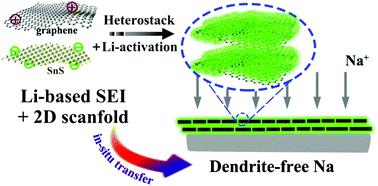当前位置:
X-MOL 学术
›
Energy Environ. Sci.
›
论文详情
Our official English website, www.x-mol.net, welcomes your
feedback! (Note: you will need to create a separate account there.)
Lithium-activated SnS–graphene alternating nanolayers enable dendrite-free cycling of thin sodium metal anodes in carbonate electrolyte
Energy & Environmental Science ( IF 32.4 ) Pub Date : 2020-11-13 , DOI: 10.1039/d0ee02423f Wei Liu 1, 2, 3, 4, 5 , Zidong Chen 1, 2, 3, 4 , Zheng Zhang 1, 2, 3, 4 , Pingxian Jiang 1, 2, 3, 4 , Yungui Chen 1, 2, 3, 4, 5 , Eunsu Paek 6, 7, 8, 9 , Yixian Wang 9, 10, 11, 12 , David Mitlin 9, 10, 11, 12
Energy & Environmental Science ( IF 32.4 ) Pub Date : 2020-11-13 , DOI: 10.1039/d0ee02423f Wei Liu 1, 2, 3, 4, 5 , Zidong Chen 1, 2, 3, 4 , Zheng Zhang 1, 2, 3, 4 , Pingxian Jiang 1, 2, 3, 4 , Yungui Chen 1, 2, 3, 4, 5 , Eunsu Paek 6, 7, 8, 9 , Yixian Wang 9, 10, 11, 12 , David Mitlin 9, 10, 11, 12
Affiliation

|
Sodium metal battery (SMB, NMB) anodes can become dendritic due to an electrochemically unstable native Na-based solid electrolyte interphase (SEI). Herein Li-ion activated tin sulfide graphene nanocomposite membrane (A-SnS–G) is employed as an artificial SEI layer, allowing cyclability of record-thin 100 μm Na metal foils. The thin Na metal is prepared by a self-designed metallurgical rolling protocol. A-SnS–G is initially placed onto the polypropylene (PP) separator but becomes in situ transferred onto the Na metal surface. Symmetric metal cells protected by A-SnS–G achieve low-overpotential extended high-rate cycling in a standard carbonate electrolyte (EC : DEC = 1 : 1, 5% FEC). Accumulated capacity of 1000 mA h cm−2 is obtained after 500 cycles at 4 mA cm−2, with accumulated capacity-to-foil capacity (A/F) ratio of 90.9. This is among the most favorable cycle life, accumulated capacity, and anode utilization combinations reported. Protection by non-activated SnS–G membrane yields significantly worse cycling, albeit still superior to the baseline unprotected sodium. Post-mortem and dedicated light optical analysis indicate that metal swelling, dendrite growth and dead metal formation is extensive for the unprotected sample, but is suppressed with A-SnS–G. Per XPS, post-100 cycles near-surface structure of A-SnS–G is rich in metallic Sn alloys and inorganic carbonate salts. Even after 300 cycles, Li-based SEI components ROCO2-Li, Li2CO3 and LiF are detected with A-SnS–G. As a proof of principle, an SMB with a high mass loading (6 mg cm−2) NVP cathode and a A-SnS–G protected anode delivered extended cyclability, achieving 74 mA h g−1 after 400 cycles at 0.4C.
中文翻译:

锂激活的SnS-石墨烯交替纳米层可实现碳酸盐电解质中钠金属阳极的无枝晶循环
钠金属电池(SMB,NMB)的阳极会由于电化学不稳定的天然Na基固体电解质中间相(SEI)而变成树枝状。本文将锂离子活化的硫化锡石墨烯纳米复合膜(A-SnS–G)用作人工SEI层,从而使记录厚度为100μm的Na金属箔具有可循环性。钠薄金属是通过自行设计的冶金轧制方案制备的。A-SnS–G最初放置在聚丙烯(PP)隔板上,但随后就地转移到Na金属表面上。由A-SnS–G保护的对称金属电池可在标准碳酸盐电解质(EC:DEC = 1:1,5%FEC)中实现低电势扩展的高倍率循环。在4 mA cm -2下进行500次循环后,获得1000 mA h cm -2的累积容量,累积容量/箔容量(A / F)为90.9。这是报告的最有利的循环寿命,累积容量和阳极利用率的组合之一。尽管仍优于基线未保护的钠盐,但未激活的SnS–G膜的保护作用会显着降低循环质量。验尸和专用光光学分析表明,对于未经保护的样品,金属膨胀,枝晶生长和死金属形成广泛,但被A-SnS–G抑制。根据XPS,A-SnS–G的100个循环后近表面结构富含金属锡合金和无机碳酸盐。即使经过300次循环,Li基SEI组分ROCO 2 -Li,Li 2 CO 3用A-SnS–G检测到LiF和LiF。作为原理证明,具有高质量负载(6 mg cm -2)NVP阴极的SMB和受A-SnS–G保护的阳极提供了扩展的循环能力,在0.4C下经过400次循环后达到74 mA hg -1。
更新日期:2020-12-17
中文翻译:

锂激活的SnS-石墨烯交替纳米层可实现碳酸盐电解质中钠金属阳极的无枝晶循环
钠金属电池(SMB,NMB)的阳极会由于电化学不稳定的天然Na基固体电解质中间相(SEI)而变成树枝状。本文将锂离子活化的硫化锡石墨烯纳米复合膜(A-SnS–G)用作人工SEI层,从而使记录厚度为100μm的Na金属箔具有可循环性。钠薄金属是通过自行设计的冶金轧制方案制备的。A-SnS–G最初放置在聚丙烯(PP)隔板上,但随后就地转移到Na金属表面上。由A-SnS–G保护的对称金属电池可在标准碳酸盐电解质(EC:DEC = 1:1,5%FEC)中实现低电势扩展的高倍率循环。在4 mA cm -2下进行500次循环后,获得1000 mA h cm -2的累积容量,累积容量/箔容量(A / F)为90.9。这是报告的最有利的循环寿命,累积容量和阳极利用率的组合之一。尽管仍优于基线未保护的钠盐,但未激活的SnS–G膜的保护作用会显着降低循环质量。验尸和专用光光学分析表明,对于未经保护的样品,金属膨胀,枝晶生长和死金属形成广泛,但被A-SnS–G抑制。根据XPS,A-SnS–G的100个循环后近表面结构富含金属锡合金和无机碳酸盐。即使经过300次循环,Li基SEI组分ROCO 2 -Li,Li 2 CO 3用A-SnS–G检测到LiF和LiF。作为原理证明,具有高质量负载(6 mg cm -2)NVP阴极的SMB和受A-SnS–G保护的阳极提供了扩展的循环能力,在0.4C下经过400次循环后达到74 mA hg -1。











































 京公网安备 11010802027423号
京公网安备 11010802027423号